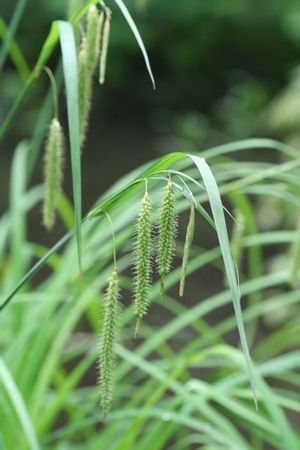Printed at http://www.newmoonnursery.com/index.cfm/
Carex crinita
Fringed sedge
Native to North America
FIRST IMPRESSIONS: Carex crinita is a tufted perennial sedge with shiny evergreen leaves. Plants gradually form large colonies that are lovely when reflected in the water. In late spring drooping bristly flower spikelets top the gracefully shaggy foliage. Golden brown seed clusters follow. This is a sedge for sunny sites with moist or wet soil.
HABITAT & HARDINESS: Carex crinita is native to eastern and parts of central North America from Manitoba to Quebec and south from Minnesota to Texas and from Maine to Georgia.
Plants are indigenous to sedge meadows, wet prairies, marshes, seeps, swamps, bogs, open areas in floodplain forests, shorelines and ditches. This sedge also grows in moist upland habitats.
Hardy from USDA Zones 3-9.
PLANT DESCRIPTION: Carex crinita is a vigorous evergreen sedge that grows in dense clumps often forming large hummocks. Plants produce many leafy culms that reach a 2-3’ height before flowering.
The leaves are glossy and strap shaped with color that varies from bright green to blue green.
In summer the culms rise above the foliage displaying drooping fringe-like spikelets. The inflorescences are gray green and bristly due to their prickly pistillate scales. The unique tassely spikelets are about 4” long and are very mobile – moving in the slightest breeze.
The pistillate spikelets are densely packed with perigynia or inflated sacs that enclose the pistils and seed. As the seed matures, the perigynium takes on a golden brown color. Eventually it breaks off and floats away transporting the achene to a new home.
Plants are about 4’ tall with an equal spread.
CULTURAL & MAINTENANCE NEEDS: Carex crinita thrives in full sun or partly shaded sites with moist or wet soil.
Plants tolerate heavy clay, seasonal flooding and will prosper in standing water or in moist upland sites.
Plants are pest resistant and unpalatable to deer and other herbivores.
LANDSCAPE USES: Carex crinita is valuable for Wetland Restoration and soil retention in Bioswales and drainage ditches. This sedge is useful in Wet Meadows and is a good component for a Grouping or Mass Planting. Plants provide Erosion Control and are appropriate for Deer Resistant Plantings, Low Maintenance Plantings, Rain Gardens, Shade Gardens and Wildlife Gardens.
COMPANION & UNDERSTUDY PLANTS: Try pairing plants with Asclepias incarnata, Lobelia cardinalis, Iris versicolor, Iris virginica and Juncus effusus.
Carex hystericina and Carex comosa are similar in appearance and cultural needs and can be substituted if needed.
TRIVIA: Carex crinita and other wetland sedges host caterpillars of Eyed Brown Butterflies and several species of Skippers and moths. Many wetland birds feed on the seed. The Sedge Wren feeds and nests in sites dominated by wetland sedges.
The perigynium is a distinguishing feature of Carex spp. This is a bag-like bract that encloses the pistillate flowers. The perigynia persists after fertilization and surrounds the resulting achenes or seed. The spikelets of Carex crinita seem to be bristly but on close inspection the spikelet scales rather than the perigynia have the teeth. A similar species Carex comosa has perigynia with unique large curved teeth on the beak. The teeth cause the spikelet to feel like velcro. A third relative Carex hystericina has shorter straight teeth on the perigynium.
Height:
3-4 ftSpread:
3-4 ftSpacing:
6-8 ftUSDA Hardiness Zone:
3-9Bloom Color:
Blue, GreenCarex crinita Characteristics
Exposure
- Partial Shade to Full Sun
Flowering Months
- June
Foliage Color
- Blue-Green
Grass Season
- Cool Season Grass
Soil Moisture Preference
- Wet to Moist
Interesting Notes:
For more information on this plant, visit the USDA PLANTS Database: http://plants.usda.gov/java/profile?symbol=CACR6

